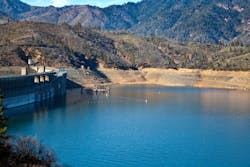California agency settles with EPA over lake pollution
SAN FRANCISCO — The California Department of Transportation (Caltrans) and Tutor-Saliba Corporation, its general contractor, agreed to settle with the U.S. Environmental Protection Agency (EPA) for polluting Shasta Lake, according to a press release.
Caltrans and Tutor-Saliba will pay $80,000 each to resolve allegations of violations at the Antlers Bridge Replacement project site near Redding, noted the release. EPA inspections in 2011 and 2013 found that Caltrans did not prevent stormwater runoff from entering Shasta Lake, a violation of the state’s Construction Storm Water General Permit and the Clean Water Act.
"Shasta Lake is our state’s largest drinking water reservoir, and protecting it from pollutants associated with highway construction is a priority for EPA," said Jared Blumenfeld, EPA’s regional administrator for the Pacific Southwest, in the release. "California’s drought means we need to do all we can to safeguard our dwindling water supplies from contamination."
The ETA estimated Caltrans discharged about 33,000 pounds of sediment into the lake, stated the release. The agency must continue to install and maintain erosion and sediment controls under the settlement.
Between 2011 and 2013, Tutor-Saliba discharged 8.5 gallons of diesel fuel, 50 gallons and hydraulic fluid and hundreds and gallons of dewatering slurry into the lake on 25 occasions, reported the release. The leaks/spills were self-reported, but not covered by a permit. Tutor-Saliba is one of the country’s largest general contractors.
The Antlers Bridge is one of the primary trucking routes on the West Coast, and heavy use has stressed the bridge as it stands more than two decades past its 50-year design life, shared the release. Once completed, the $129 million bridge will have a lifespan of 100 years.
You can find the entire release here.
